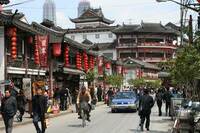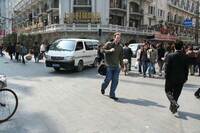- England
- Scotland
- France
- Holland
- Germany
- Italy
- Spain
- Portugal
- USA
- China
- Japan
- India
- Iran
- Advice
- Gardens
- England
- Scotland
- France
- Holland
- Germany
- Italy
- Spain
- Portugal
- USA
- China
- Japan
- India
- Iran
- Advice
- Garden Tours
Book: Landscape Planning and Environmental Impact Design: from EIA to EID
Chapter: Chapter 10 Sustainable green transport
If the are to succeed, knowledge, imagination and design judgement must be employed. The practice of excluding all vehicles, in order to deal with their negative sideï¾effects, has been applied to shopping streets with high pedestrian flows. It has often been successful, though a surprisingly low level of design effort goes into most pedestrianisation schemes. Too often, 'paving patterns' are rolled out like cheap carpets, without serious consideration being given to functional, aesthetic or archetypal considerations, or to the local vernacular. Pedestrianisation thus becomes an excuse for 'substituting street furniture clutter for vehicular clutter' (Toulson 1984). The better schemes have either been the result of using traditional patterns and materials, or of holding competitions to produce a unique design solution. A design choice has to be made at the outset of a pedestrianisation project. Rouen was the first French city to adopt the idea of pedestrianisation. Germany has a great many successful schemes [Fig 10.21] and has often used design competitions. Isezaki Mall in Yokohama also has a very elaborate paving pattern. The worst approach to pedestrianisation, often employed in Britain, is to send the scheme down to a junior employee in the planning or highways department to experiment with the latest range of concrete paving products. The results are tacky. Town centres require a special type of street which functions like a gracious pedestrian mall but is accessible to permitted vehicles. If ways can be found of permitting busses, taxis, pedestrians and cyclists, they will contribute to the convenience of users, and to the life, bustle and variety of the town. Delivery vehicles can use the space out of hours. It can be called a BaTaPaC road (for Busses and Taxis and Pedestrians and Cyclists). The mix is desirable, because excitement and communication are two of the most attractive features of towns. Permits, either electronic or physical, can be issued on a short- or long-term basis to specified categories of vehicle travelling at less than 10 km/hour. At very busy times, all wheeled access may be stopped. The design criteria for town centre streets should be related to social, aesthetic and environmental considerations.

